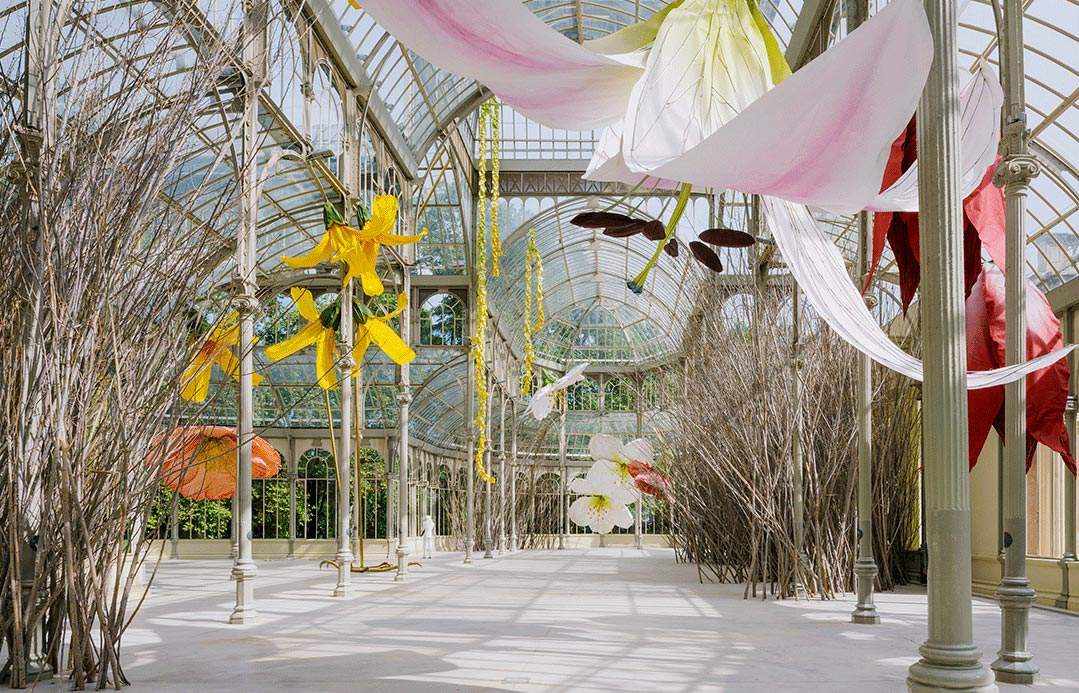Madrid, the Palacio del Cristal becomes a spectacular nest: the work of Petrit Halilaj
It’s called To a raven and hurricanes that from unknown places bring back smells of humans in love, the intervention with which Kosovar artist Petrit Halilaj (Kostërrc, 1986) has changed the face of the Palacio de Cristal in Madrid: the building has been transformed into a huge nest filled with flowers and birds, typical elements of the young artist’s poetics (to which we dedicated a long in-depth article in the last issue of our print magazine). And it can be seen like this until next February 28, 2021. His work draws heavily from his troubled autobiographical background: as a child, at the age of thirteen, because of the war he was forced to live for two years in a refugee camp and to leave Kosovo, his country.
The drama of the war and his childhood pain thus resurface through his artworks, which speak of themes such as home and cultural identity, and they do so in different mediums: installations, videos, sculptures, drawings. His Madrid intervention, organized by the Reina Sofía Museum, is no exception: this is his first solo show in Spain, for which he was invited to create a “drama of his life.” Halilaj, organizers let organizers know, took the invitation literally and transformed, as mentioned, the Palacio de Cristal into an ido connecting the inside and outside of the palace, taking visitors on an ideal journey in and out of the building. The birds arriving from the Parque del Retiro are the most obvious example: birds, in Petrit Halilaj’s art, symbolize the ability to transcend the boundaries established by thought, to cross boundaries.
The nest of Palacio de Cristal is enveloping and colorful, and large flowers pop up every now and then, steel works made in collaboration with Álvaro Urbano, the artist’s partner (a work partner but also a life partner): there are forsythias, palm seeds, cherry blossoms, poppies, carnations, lilies, each of which takes on a social and political significance. Also present is another very important element for the artist, the white raven, which alludes to the theme of diversity and the ability to resist changing oneself in order to be accepted: in this sense, the animal becomes a metaphor for many things, such as homosexuality and its non-recognition by broad layers of Kosovar society but not only.
As is the case in nature, in Halilaj’s art the nest cannot be considered an autonomous space, but a continuation of what it has around it: this relationship is for the artist a form of interdependence that emerges from the entire installation. Moreover, the work’s outsized dimensions are meant to signify the fact that man is not the center of the world, but is, if anything, one of its many elements. “The nest,” the presentation reads, “is thus revealed as the setting for a ritual that makes sure that the encounters, alliances and unions between its different visitors actually take place, modifying and changing along with the space.”
To a raven and hurricanes that from unknown places bring back smells of humans in love is also the Reina Sofía Museum’s first exhibition since its closure due to the Covid-19 health emergency. Consequently, according to the artist, it is also possible to read his work according to this topical key: a work that aims to raise awareness around the fragility of our economic system and the unsustainability of the paradigm of unlimited growth at the expense of nature. The virus has confronted us with our vulnerability: for Halilaj, the nest is a refuge and opens up hope for a better future.
In the photo by ImagenSubliminal (Miguel de Guzmán + Rocío Romero), a view of the installation.
 |
| Madrid, the Palacio del Cristal becomes a spectacular nest: the work of Petrit Halilaj |
Warning: the translation into English of the original Italian article was created using automatic tools. We undertake to review all articles, but we do not guarantee the total absence of inaccuracies in the translation due to the program. You can find the original by clicking on the ITA button. If you find any mistake,please contact us.




























